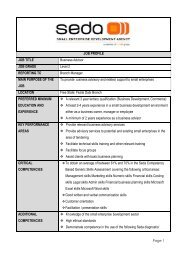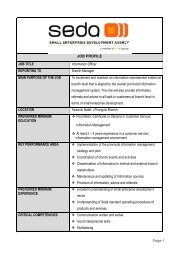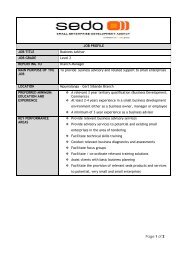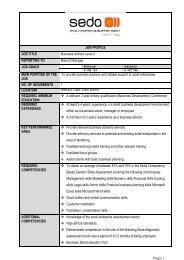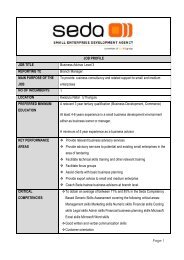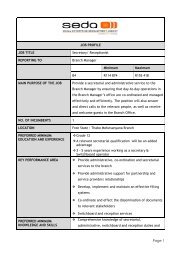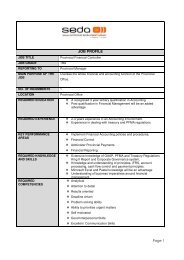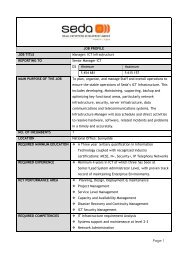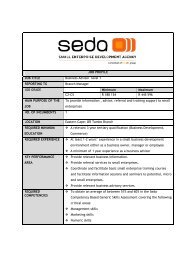Assessment of Cooperatives in the Poultry Industry - 2013.pdf - Seda
Assessment of Cooperatives in the Poultry Industry - 2013.pdf - Seda
Assessment of Cooperatives in the Poultry Industry - 2013.pdf - Seda
You also want an ePaper? Increase the reach of your titles
YUMPU automatically turns print PDFs into web optimized ePapers that Google loves.
Research Report: Address<strong>in</strong>g <strong>the</strong> Needs, Opportunities and Challenges <strong>of</strong> <strong>Cooperatives</strong><br />
and Collectively Owned Enterprises <strong>in</strong> <strong>the</strong> <strong>Poultry</strong> and Related Industries<br />
Figure 4-18: Ma<strong>in</strong> Cooperative Challenges at Present<br />
Lack <strong>of</strong> equipment<br />
F<strong>in</strong>ancial assistance required<br />
16%<br />
16%<br />
Infrastructure upgrades required<br />
14%<br />
Tra<strong>in</strong><strong>in</strong>g required<br />
9%<br />
Lack <strong>of</strong> transport<br />
8%<br />
F<strong>in</strong>ancial management<br />
Theft<br />
Input costs<br />
7%<br />
7%<br />
7%<br />
O<strong>the</strong>r<br />
16%<br />
0% 2% 4% 6% 8% 10% 12% 14% 16% 18%<br />
Source: Urban-Econ Survey, 2013<br />
Without proper tra<strong>in</strong><strong>in</strong>g, however, even <strong>the</strong> best chicken houses are not successful. Some 9% <strong>of</strong><br />
cooperatives <strong>in</strong>terviewed stated that <strong>the</strong>y lack tra<strong>in</strong><strong>in</strong>g.<br />
The category <strong>of</strong> “o<strong>the</strong>r” above <strong>in</strong>cluded <strong>in</strong>appropriate premises, too many competitors, high<br />
mortality rates <strong>of</strong> birds, and a lack <strong>of</strong> electricity and water. The challenges seen above re-iterate<br />
what has been shown <strong>in</strong> <strong>the</strong> background and f<strong>in</strong>ancial management sections above. The greatest<br />
concerns perceived by cooperatives are overwhelm<strong>in</strong>gly; equipment, f<strong>in</strong>ancial assistance, tra<strong>in</strong><strong>in</strong>g<br />
programs, and transport vehicles.<br />
<strong>Cooperatives</strong> were asked whe<strong>the</strong>r <strong>the</strong>y believe<br />
<strong>the</strong>ir bus<strong>in</strong>ess is successful or not. While this is a<br />
highly subjective question, <strong>the</strong> responses provide<br />
some <strong>in</strong>sights <strong>in</strong>to <strong>the</strong> cooperatives’ own<br />
perception on whe<strong>the</strong>r <strong>the</strong>y are susta<strong>in</strong>able. Some<br />
40% <strong>of</strong> cooperatives<br />
consider <strong>the</strong>ir bus<strong>in</strong>ess to<br />
be successful<br />
40% <strong>of</strong> cooperatives consider <strong>the</strong>ir bus<strong>in</strong>ess to be successful. They consider <strong>the</strong> bus<strong>in</strong>ess to be<br />
successful ma<strong>in</strong>ly due to <strong>the</strong> follow<strong>in</strong>g three factors: a strong customer base, high levels <strong>of</strong> sales and<br />
good quality products. Interest<strong>in</strong>gly, when look<strong>in</strong>g at <strong>the</strong> positive features <strong>of</strong> <strong>the</strong>ir bus<strong>in</strong>ess,<br />
cooperatives mention demand side factors i.e. sales and product quality. However, where<br />
cooperatives view <strong>the</strong>ir bus<strong>in</strong>ess as unsuccessful, <strong>the</strong>y attribute <strong>the</strong> failure to <strong>in</strong>ternal features.<br />
Figure 4-19 below identifies <strong>the</strong> factors cooperatives believe are contribut<strong>in</strong>g towards an<br />
unsuccessful bus<strong>in</strong>ess. The three categories identified are <strong>in</strong>frastructural deficiencies, operational<br />
deficiencies and decl<strong>in</strong><strong>in</strong>g pr<strong>of</strong>its.<br />
63 | P a g e U r b a n - E c o n : D e v e l o p m e n t E c o n o m i s t s



